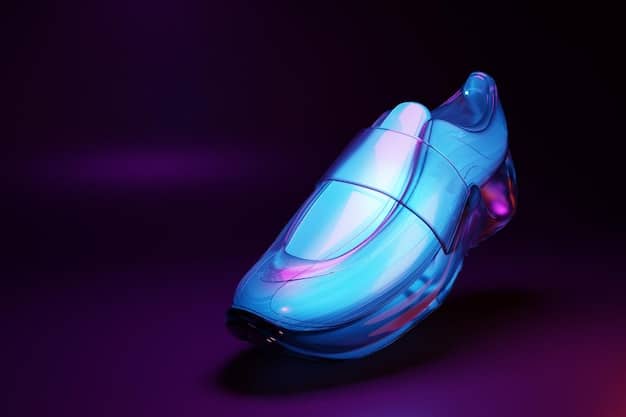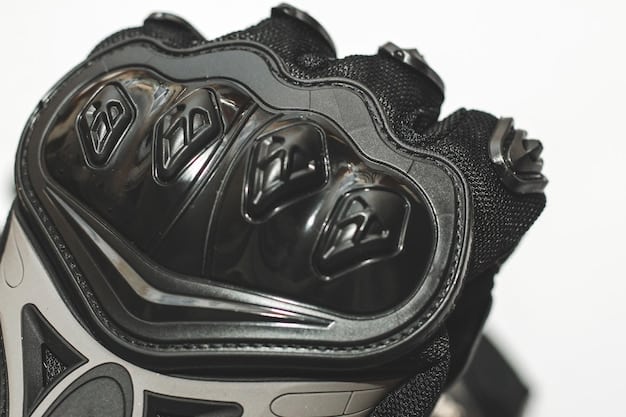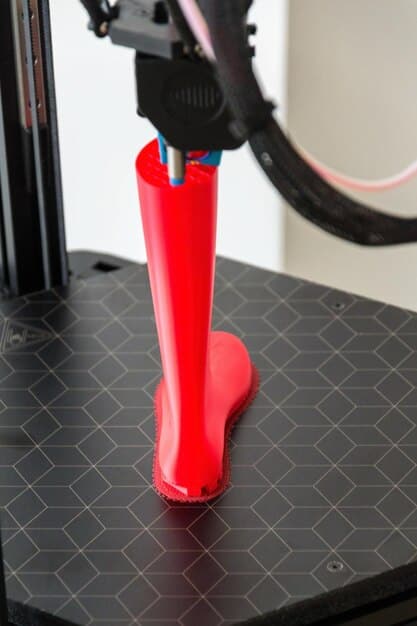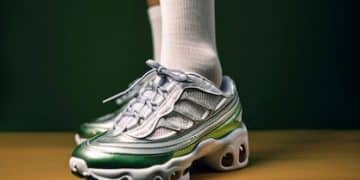The Future of Sneaker Tech: Innovations in the Next 5 Years

The Future of Sneaker Technology: Innovations to Expect in the Next 5 Years includes self-lacing systems, sustainable materials, 3D-printed components, smart sensors for performance tracking, and augmented reality integration for enhanced customization and consumer experience.
The world of sneakers is constantly evolving, driven by technological advancements and changing consumer expectations. Prepare to step into the future as we explore The Future of Sneaker Technology: Innovations to Expect in the Next 5 Years, a journey into the cutting-edge designs and functionality that will redefine footwear.
The Rise of Self-Lacing Sneakers
Self-lacing sneakers, once the realm of science fiction, are quickly becoming a reality. Major brands are investing heavily in this technology, promising a more convenient and personalized fit.
But what’s driving this trend, and what can we expect in the coming years?
The Technology Behind Self-Lacing
Self-lacing systems typically rely on a network of sensors, motors, and cables integrated into the shoe. These components work together to automatically tighten or loosen the laces based on the wearer’s foot shape and activity level.
Benefits of Self-Lacing Sneakers
The advantages of self-lacing sneakers are numerous. They offer a more secure and consistent fit, reduce the risk of tripping, and can be adjusted on the fly. This is especially beneficial for athletes and people with mobility issues.
- Enhanced Comfort: Self-lacing allows for micro-adjustments throughout the day.
- Improved Performance: A secure fit translates to better stability and responsiveness.
- Accessibility: Easier to put on and take off, especially for individuals with disabilities.
In conclusion, self-lacing technology is revolutionizing the way we interact with our footwear, offering a blend of convenience, performance, and accessibility.

Sustainable Materials: A Greener Footprint
The sneaker industry is facing increasing pressure to reduce its environmental impact. As a result, sustainable materials are becoming a central focus in sneaker design and manufacturing.
Expect to see even more eco-friendly options in the years to come.
Innovations in Recycled Materials
Sneaker brands are actively exploring the use of recycled materials, such as plastic bottles, ocean plastic, and recycled rubber. These materials are being incorporated into various parts of the shoe, from the upper to the sole.
The Rise of Bio-Based Materials
Bio-based materials, derived from renewable resources like plants and algae, are gaining traction as sustainable alternatives to traditional synthetic materials. These materials offer similar performance characteristics while minimizing reliance on fossil fuels.
- Reducing Waste: Utilizing recycled materials diverts waste from landfills.
- Lowering Carbon Footprint: Bio-based materials often require less energy to produce.
- Creating Durable Products: Sustainable materials can be just as strong and long-lasting.
These advancements offer a path towards a more sustainable and responsible sneaker industry, reducing waste and minimizing environmental impact.
3D Printing: Customization and Performance
3D printing technology is poised to transform the sneaker industry, enabling unprecedented levels of customization and performance optimization. Expect to see even more innovative applications of 3D printing in the coming years.
How is 3D printing changing the game?
Customized Midsoles
3D printing allows for the creation of customized midsoles that are tailored to the individual wearer’s foot shape and biomechanics. This results in improved comfort, support, and energy return.
On-Demand Manufacturing
3D printing also enables on-demand manufacturing of sneakers, reducing waste and allowing for faster prototyping and production cycles. This agility is crucial in responding to rapidly changing consumer demands.

- Personalized Fit: Customized midsoles provide superior comfort and support.
- Reduced Waste: On-demand manufacturing minimizes overproduction.
- Faster Innovation: Rapid prototyping accelerates the development of new designs.
In the future, 3D printing will play a crucial role in creating sneakers that are both highly personalized and environmentally sustainable.
Smart Sneakers: Integrating Sensors for Performance Tracking
Smart sneakers, equipped with embedded sensors, are offering athletes and fitness enthusiasts valuable insights into their performance. Expect these technologies to become even more sophisticated and integrated in the near future.
What key features can you expect?
Real-Time Data Monitoring
Smart sneakers can track a variety of metrics, including distance, speed, cadence, and ground contact time. This data is then transmitted to a smartphone app for real-time monitoring and analysis.
AI-Powered Coaching
Some smart sneakers are also incorporating AI-powered coaching features, providing personalized feedback and training recommendations based on the wearer’s performance data. This elevates the training experience beyond simple tracking.
- Data-Driven Insights: Track key metrics to optimize training and performance.
- Personalized Coaching: Receive tailored feedback based on individual data.
- Injury Prevention: Monitor biomechanics to identify potential risks.
Smart sneakers provide athletes with the data and insights they need to improve their performance, prevent injuries, and reach their full potential.
Augmented Reality: Enhancing the Sneaker Experience
Augmented reality (AR) is poised to transform the way consumers interact with sneakers, offering new ways to personalize, customize, and experience footwear. AR technology is set to enhance both the shopping and wearing experience.
How will AR impact the sneaker world?
Virtual Try-Ons
AR technology allows consumers to virtually try on sneakers using their smartphones or tablets. This eliminates the need to physically visit a store, making online shopping more convenient and engaging.
Personalized Customization
AR can also be used to personalize sneakers, allowing consumers to visualize different color combinations, patterns, and designs before making a purchase. This enhances the creative process and empowers users.
- Convenient Shopping: Try on sneakers from the comfort of your home.
- Creative Customization: Design your perfect pair with AR tools.
- Enhanced Engagement: Interact with sneakers in a whole new way.
AR is set to revolutionize the sneaker industry, blurring the lines between the physical and digital worlds and offering consumers unparalleled levels of personalization and engagement.
The Impact of Blockchain on Sneaker Authenticity
Blockchain technology is emerging as a powerful tool for combating counterfeit sneakers and ensuring the authenticity of limited-edition releases. Look for wider adoption of blockchain in the next few years.
How can blockchain help with authentication?
Creating Unique Digital Identities
Blockchain allows each sneaker to be assigned a unique digital identity that is stored on a decentralized ledger. This makes it virtually impossible for counterfeiters to replicate authentic sneakers.
Transparent Supply Chains
Blockchain can also be used to track the entire supply chain of a sneaker, from the factory to the retailer. This provides consumers with greater transparency and confidence in the authenticity of their purchase.
- Combating Counterfeits: Blockchain provides a secure way to verify authenticity.
- Ensuring Transparency: Track sneakers from origin to purchase.
- Building Trust: Increase consumer confidence in limited-edition releases.
Blockchain is set to play a crucial role in protecting consumers from counterfeit sneakers and ensuring the integrity of the sneaker market.
| Key Point | Brief Description |
|---|---|
| 👟 Self-Lacing Tech | Automated fit adjustment for enhanced comfort and performance. |
| 🌱 Sustainable Materials | Eco-friendly options reducing environmental impact. |
| 🖨️ 3D Printing | Customized midsoles for tailored fit and performance. |
| 📱 Augmented Reality | Virtual try-ons and personalized customization. |
FAQ
▼
Self-lacing sneakers use electronic systems to automatically tighten and loosen laces, offering a personalized fit and reducing the risk of tripping. They enhance comfort and convenience for users.
▼
3D printing allows for customized midsoles tailored to individual foot shapes, enhancing comfort, support, and performance. This accelerates prototyping and reduces waste through on-demand manufacturing.
▼
Smart sneakers track metrics like distance, speed, and cadence, offering real-time data and AI-powered coaching. This helps athletes optimize training, prevent injuries, and gain insights into their performance.
▼
Augmented reality enables virtual try-ons, allowing customers to visualize sneakers on their feet using smartphones. It also facilitates personalized customization, improving the online shopping experience.
▼
Blockchain assigns unique digital identities to sneakers, creating a decentralized ledger that verifies authenticity. This technology tracks supply chains, combats counterfeits, and enhances trust in limited-edition releases.
Conclusion
As we look ahead, the future of sneaker technology holds immense promise. Innovations in self-lacing, sustainable materials, 3D printing, smart sensors, and augmented reality are set to redefine the way we design, manufacture, and experience sneakers. These advancements will not only enhance performance and customization but also drive sustainability and transparency in the industry.





